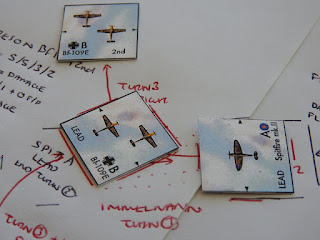I played out the basic dogfight scenario today, with a section of three Spitfires against a schwarm of four Bf-109e's, flipping one of the Spitfire counters to represent a standard vic formation, as deployed by the RAF at the start of the Battle of Britain. As usual, I plotted all of the moves on an A2 sheet so that I could keep tabs on the action, but you don't need to do this if you just want to play the game.
In the end, the RAF came off as the underdogs, losing the lone Spitfire to a frontal attack in Turn 2 and the flight leader's wingman in the same turn, again to a frontal attack by the cannon armed Bf-109's. The dogfight then became a classic turning skirmish, with the last remaining Spitfire desperately manoeuvring to avoid further bursts of fire from the Bf-109 Schwarmfuhrer.
After several near misses, with both sides managing to hit but failing to damage their opponent due to very poor dice rolling, the Spitfire leader decided to hit the deck and head for home, as his aircraft was by now full of holes and probably a total right off. The Luftwaffe fighters followed close behind all of the way but still failed to shoot down the RAF fighter, despite trying very hard to do so before he could make good his getaway.
The final outcome was a marginal victory for the Luftwaffe, who started out with a numerical advantage but ultimately failed to shoot down all three of the RAF fighters. The RAF by contrast got a pasting and failed to shoot down any of the Luftwaffe machines. A good game and an easy way to familiarise myself with the rules, although the energy rules for a wingover cropped up again as a bit of a sticking point.
I may well reduce the energy cost for both the Immelmann and wingover as a result, with only one point of energy required for each manoeuvre respectively. I think this would work better and would enable most fighters to perform these basic tactical moves without any restrictions, which would seem to be more realistic, if a little one size fits all.
Tally Ho!

















